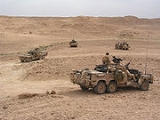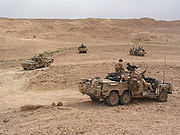
Land Rover Perentie
Encyclopedia
The Land Rover Perentie is a vehicle in use by the Australian Army
, produced in Australia
and based on the Land Rover Defender 110. It was introduced in 1987 to replace the ageing fleet of Series 2A and 3
Land Rovers, and is still in service. Produced in 4 x 4 and 6 x 6
variants and powered by an Isuzu
3.9 litre four cylinder diesel engine
, it has proven itself both in Australia and on overseas military operations.
The major differences from British Land Rovers are the relocation of the spare wheel to under the rear of the load area, a galvanised chassis and the Isuzu engine, which was also commonly used in the 1980s on Australian-built long-wheelbase civilian versions of the Series and Defender Land Rovers. The 6 x 6 version has a wider cab and leaf-sprung
rear axles. The 6 x 6 also has a turbocharger
. The original order was for 2,500 4 x 4 and 400 6 x 6 vehicles between 1987 and 1990; further vehicles were added later under Project Bushranger.
The designation Perentie originates from Project Perentie, the official Australian Army test to find new 1 and 2 tonne light vehicles – the perentie
(Varanus giganteus) is a large lizard
native to Australia.

Australian Army
The Australian Army is Australia's military land force. It is part of the Australian Defence Force along with the Royal Australian Navy and the Royal Australian Air Force. While the Chief of Defence commands the Australian Defence Force , the Army is commanded by the Chief of Army...
, produced in Australia
Australia
Australia , officially the Commonwealth of Australia, is a country in the Southern Hemisphere comprising the mainland of the Australian continent, the island of Tasmania, and numerous smaller islands in the Indian and Pacific Oceans. It is the world's sixth-largest country by total area...
and based on the Land Rover Defender 110. It was introduced in 1987 to replace the ageing fleet of Series 2A and 3
Land Rover Series
The Land Rover Series I, II, and III are off-road vehicles produced by the British manufacturer Land Rover that were inspired by the US-built Willys Jeep...
Land Rovers, and is still in service. Produced in 4 x 4 and 6 x 6
Six-wheel drive
Six-wheel drive, 6WD or 6x6 is a drivetrain configuration of six wheels, all of which are driven simultaneously by the vehicle's engine. Unlike four-wheel drive drivetrains, the configuration is largely confined to off-road and military vehicles, particularly heavy-duty ones...
variants and powered by an Isuzu
Isuzu
, is a Japanese car, commercial vehicle and heavy truck manufacturing company, headquartered in Tokyo. In 2005, Isuzu became the world's largest manufacturer of medium to heavy duty trucks. It has assembly and manufacturing plants in the Japanese city of Fujisawa, as well as in the prefectures...
3.9 litre four cylinder diesel engine
Diesel engine
A diesel engine is an internal combustion engine that uses the heat of compression to initiate ignition to burn the fuel, which is injected into the combustion chamber...
, it has proven itself both in Australia and on overseas military operations.
The major differences from British Land Rovers are the relocation of the spare wheel to under the rear of the load area, a galvanised chassis and the Isuzu engine, which was also commonly used in the 1980s on Australian-built long-wheelbase civilian versions of the Series and Defender Land Rovers. The 6 x 6 version has a wider cab and leaf-sprung
Leaf spring
Originally called laminated or carriage spring, a leaf spring is a simple form of spring, commonly used for the suspension in wheeled vehicles...
rear axles. The 6 x 6 also has a turbocharger
Turbocharger
A turbocharger, or turbo , from the Greek "τύρβη" is a centrifugal compressor powered by a turbine that is driven by an engine's exhaust gases. Its benefit lies with the compressor increasing the mass of air entering the engine , thereby resulting in greater performance...
. The original order was for 2,500 4 x 4 and 400 6 x 6 vehicles between 1987 and 1990; further vehicles were added later under Project Bushranger.
The designation Perentie originates from Project Perentie, the official Australian Army test to find new 1 and 2 tonne light vehicles – the perentie
Perentie
The Perentie is the largest monitor lizard or goanna native to Australia, and fourth largest lizard on earth, after the Komodo Dragon, crocodile monitor and the water monitor...
(Varanus giganteus) is a large lizard
Lizard
Lizards are a widespread group of squamate reptiles, with nearly 3800 species, ranging across all continents except Antarctica as well as most oceanic island chains...
native to Australia.
4X4 Variants
- Truck, Utility, Lightweight, MC2 (Mobility Category 2) (1222 Vehicles)
- Truck, Utility, Lightweight, Winch, MC2 (314 Vehicles)
- Truck, Utility, Lightweight, FFR (Fitted For Radio), MC2 (964 Vehicles)
- Truck, Utility, Lightweight, FFR, Winch, MC2 (208 Vehicles)
- Truck, Panel, Lightweight, Survey, FFR, Winch, MC2 (35 Vehicles)
- Truck, Carryall, Lightweight, Senior Commander, FFR, Winch, MC2 (11 Vehicles)
- Truck, Carryall, Lightweight, Personnel Carrier, MC2 (38 Vehicles)
- Truck, Surveillance, Lightweight, Winch, MC2 (RFSV) (231 Vehicles)
6X6 Variants

- Truck, Cargo, Light, MC2 (215 Vehicles)
- Truck, Cargo, Light, Winch, MC2 (32 Vehicles)
- Truck, Ambulance, 4 Litter, FFR, Winch, MC2 (94 Vehicles)
- Truck, General Maintenance, Light, Winch, MC2 (GMV) (181 Vehicles)
- Truck, Electronic Repair, Light, MC2 (ERV) (40 Vehicles) and Truck, Comsec Repair Workshop *Vehicle, Light, MC2 (12 Vehicles)
- Truck, Long Range Patrol, Light, Winch, MC2 (LRPV) (27 Vehicles)
- Truck, Air Defence, Light, FFR, Winch, MC2 (72 Vehicles)
- Truck, Crew Cab, Light, Winch, MC2 (26 Vehicles)
- Truck, Infantry Improvised Mobility Vehicle, MC2 (number unknown)

